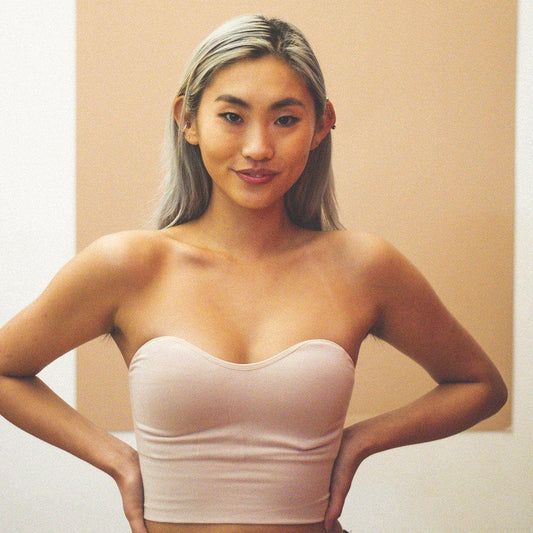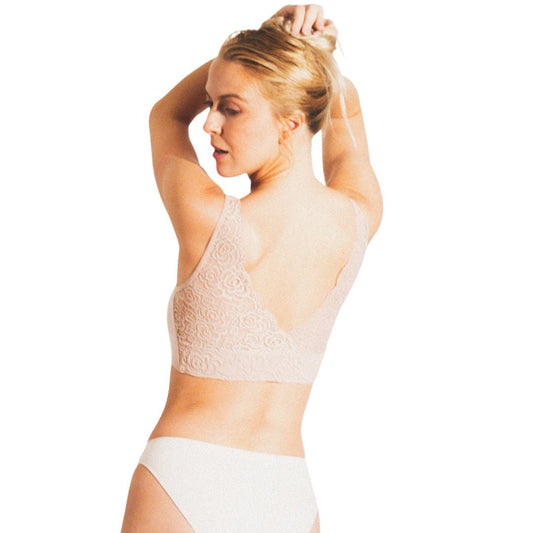
From Bust Size to Cup: Unveiling the Secrets of Finding the Perfect Fit
Are you tired of uncomfortable bras that don't fit properly? Don't worry, we've got you covered! In this article, we will reveal the secrets to finding the perfect fit for your bust size and cup. Whether you're an A or a DD, we understand that everyone's body is unique, and finding the right bra can be a daunting task. But fear not, because we have done the research for you.
With our expert advice and tips, you'll be able to achieve the ultimate level of comfort and support. We'll debunk common misconceptions and help you understand how bra sizing works. From measuring your bust size to determining the right cup size, we will provide guidance every step of the way.
Finding the perfect fit is not just about looking good; it's also about feeling confident and comfortable in your own skin. So why settle for less when you can have it all? Get ready to dive into the world of bra fitting and discover the secrets to finding your perfect match. Say goodbye to discomfort and hello to a new level of confidence!
Understanding the Importance of a Proper Fit
Having a properly fitting bra is crucial for both comfort and support. When your bra fits correctly, it can help alleviate discomfort, enhance your natural shape, and prevent sagging. Many women underestimate the importance of a good fit and settle for bras that are too small or too large, leading to discomfort and an unsatisfactory appearance.
One common misconception is that the band size determines the fit of the bra. While the band does play a role, the cup size is equally important. A well-fitting bra should provide support from the band while ensuring that the cups encase your breasts properly. Understanding this balance is the key to finding the perfect fit.
To achieve the ideal fit, it's essential to measure your bust size accurately and determine your cup size correctly. This will ensure that you're wearing a bra that supports and enhances your natural shape. Let's dive into the different types of bra sizing systems and learn how to measure your bust size accurately.
Different Types of Bra Sizing Systems
Bra sizing can be a confusing subject due to the various sizing systems used around the world. The most common systems are the US system, the UK system, and the European system. Each system has its own unique way of measuring and labeling bra sizes.
In the US system, bra sizes are typically represented by a combination of letters and numbers. The band size is represented by a number (e.g., 34, 36, 38), while the cup size is represented by a letter (e.g., A, B, C). The UK system follows a similar pattern, with the band size represented by a number and the cup size represented by a letter.
On the other hand, the European system uses a different method. The band size is represented by a number, just like in the US and UK systems. However, the cup size is represented by a letter and a number (e.g., 75B, 80C, 85D).
It's important to note that while these sizing systems may differ, the underlying concept remains the same. The band size determines the fit around your ribcage, while the cup size determines how well the bra encases your breasts. Now that we understand the different sizing systems, let's move on to measuring your bust size accurately.
Measuring Your Bust Size Accurately
Measuring your bust size accurately is the first step in finding the perfect fit. To get started, you'll need a soft measuring tape and a mirror. It's best to measure yourself while wearing an unpadded bra or no bra at all for the most accurate results.
- Start by measuring your band size. Wrap the measuring tape around your ribcage, just below your breasts. Make sure the tape is parallel to the floor and snug but not too tight. Note down the measurement in inches or centimeters.
- Next, measure your bust size. Wrap the measuring tape around the fullest part of your breasts, making sure it's parallel to the floor. Take note of this measurement as well.
- To determine your cup size, subtract your band size measurement from your bust size measurement. Each inch or centimeter difference corresponds to a different cup size. For example, if your bust size is 36 inches and your band size is 34 inches, the difference is 2 inches, which corresponds to a B cup.
By following these steps, you'll have a good starting point for determining your bra size. However, keep in mind that measuring alone may not provide a perfect fit. The shape and fullness of your breasts also play a role in finding the right bra. Let's dive into determining your cup size and addressing common fitting issues.
Determining Your Cup Size
Determining your cup size is just as important as measuring your band size. The cup size indicates how well the bra encases your breasts and provides support. To determine your cup size accurately, you'll need to consider both the measurement difference and the shape of your breasts.
As mentioned earlier, each inch or centimeter difference between your band size and bust size corresponds to a different cup size. Here's a general guide to help you determine your cup size based on the measurement difference:
- 0-1 inch (0-2.5 cm) difference: AA cup
- 1-2 inches (2.5-5 cm) difference: A cup
- 2-3 inches (5-7.5 cm) difference: B cup
- 3-4 inches (7.5-10 cm) difference: C cup
- 4-5 inches (10-12.5 cm) difference: D cup
- 5-6 inches (12.5-15 cm) difference: DD cup
It's important to note that cup sizes can vary across brands and styles. So while this guide provides a general overview, it's always recommended to try on different sizes and styles to find the perfect fit for your unique shape.
In addition to the measurement difference, the shape of your breasts can also affect the fit. Breasts come in various shapes, including round, shallow, full on top, full on bottom, and more. Understanding your breast shape can help you choose bras that provide the best support and enhance your natural shape.
Now that we've covered the basics of measuring your bust size and determining your cup size, let's address common fitting issues and how to solve them.
Common Fitting Issues and How to Solve Them
Finding the perfect fit can be a challenge, especially when faced with common fitting issues. Here are some of the most common fitting issues and how to solve them:
- Gapping cups: If you notice gaps between your breasts and the cups, it may be a sign that your cup size is too big. Try going down a cup size to see if it provides a better fit.
- Spillage or bulging: On the other hand, if your breasts are spilling out of the cups or creating a bulge, it's a sign that your cup size is too small. Consider going up a cup size to ensure proper coverage and support.
- Riding up or digging straps: If your bra band is riding up your back or the straps are digging into your shoulders, it may be a sign that your band size is too big. Try going down a band size to achieve a snug and supportive fit.
- Underwire discomfort: If the underwire of your bra is poking or digging into your skin, it's likely that the cup size is too small or the shape of the bra doesn't suit your breast shape. Consider trying a larger cup size or a different bra style with a more suitable underwire shape.
By addressing these common fitting issues, you'll be able to find a bra that provides optimal comfort and support. However, keep in mind that everyone's body is unique, and what works for one person may not work for another. It's important to try on different styles and brands to find the perfect match for your body.
The Importance of Trying on Different Styles and Brands
Finding the perfect bra is not a one-size-fits-all process. Different styles and brands can vary in terms of fit, comfort, and support. What works for one person may not work for another, so it's important to explore different options and try on various styles and brands.
When trying on bras, pay attention to how they feel and how they enhance your natural shape. Look for bras that provide adequate support, encase your breasts properly, and feel comfortable against your skin. Consider trying different styles, such as balconette, plunge, or sports bras, to see which works best for your body and lifestyle.
In addition to trying on different styles, don't be afraid to explore different brands. Each brand may have its own unique sizing and fit, so what may be a 34C in one brand could be a 36B in another. Take advantage of store associates who can help you find the right fit and provide recommendations based on your measurements and preferences.
Remember, finding the perfect bra is a journey, and it may take some trial and error to find the best fit for you. Be patient and don't settle for anything less than perfect. You deserve a bra that makes you feel confident, comfortable, and supported.
Finding the Right Band Size for Optimal Support
While the cup size often takes the spotlight, the band size is equally important for optimal support. The band provides the foundation of your bra, and it should fit snugly around your ribcage without digging in or riding up.
To determine the right band size, measure your ribcage just below your breasts, making sure the measuring tape is parallel to the floor. If the measurement is an even number, add 0 inches to get your band size. If the measurement is an odd number, add 1 inch instead.
For example, if your ribcage measurement is 30 inches, adding 0 inches gives you a band size of 30. If your ribcage measurement is 31 inches, adding 1 inch gives you a band size of 32. Keep in mind that this is just a starting point, and you may need to adjust your band size based on personal preference and the brand's sizing.
A well-fitting band should feel snug but not uncomfortably tight. It should stay in place throughout the day without riding up or causing discomfort. Remember, the band provides the majority of the support, so finding the right fit is essential for a comfortable and supportive bra.
The Role of Underwire and Padding in Finding the Perfect Fit
Underwire and padding are common features in many bras, and they can play a significant role in finding the perfect fit. While some women prefer bras without underwire or padding, others find them beneficial for shaping, support, and comfort.
Underwire bras are designed to lift and shape the breasts, providing extra support and enhancing your natural shape. The underwire should encase the bottom and sides of your breasts without poking or digging into your skin. If you find the underwire uncomfortable, it may be a sign that the cup size is too small or the underwire shape doesn't suit your breast shape. Consider trying a larger cup size or a different bra style without an underwire.
Padding, on the other hand, can provide additional shaping and support. Padded bras are often preferred by those who want to enhance their natural shape or add volume. The level of padding can vary, from lightly padded to heavily padded. Choose a level of padding that suits your preferences and enhances your natural shape without sacrificing comfort.
When it comes to underwire and padding, it's all about personal preference. Some women love the shaping and support they provide, while others find them unnecessary or uncomfortable. Remember, the perfect bra is one that makes you feel confident, comfortable, and supported, so choose features that align with your needs and preferences.
Shopping Tips for Finding the Perfect Bra
Now that you've learned the secrets to finding the perfect fit, let's dive into some shopping tips to help you find the bra of your dreams:
- Know your measurements: Armed with your accurate measurements, you'll have a starting point for finding the right size. However, keep in mind that sizing can vary across brands and styles, so don't be afraid to try different sizes.
- Try before you buy: Don't be tempted to purchase bras online without trying them on first. Each brand and style can fit differently, so it's important to try them on and assess the fit and comfort before making a purchase.
- Ask for assistance: Store associates are there to help you find the perfect fit. Don't hesitate to ask for their assistance, as they can provide valuable recommendations based on your measurements and preferences.
- Don't settle for discomfort: If a bra feels uncomfortable or doesn't provide the support you need, don't settle for it. Keep trying different styles and brands until you find the perfect match for your body.
- Invest in quality: A well-made bra can make all the difference when it comes to comfort and longevity. While it may be tempting to opt for cheaper options, investing in a quality bra can provide long-term comfort and support.
Remember, finding the perfect bra is a personal journey, and it may take some time to find the right fit. Be patient, explore different options, and don't settle for anything less than perfect. Your body deserves a bra that makes you feel confident, comfortable, and supported.
Finding the perfect fit for your bust size and cup is a crucial step in achieving comfort and confidence. By understanding the importance of a proper fit, learning about different bra sizing systems, and measuring your bust size accurately, you can navigate the world of bra fitting with ease.
Remember to determine your cup size by considering both the measurement difference and the shape of your breasts. Address common fitting issues by trying different sizes and styles, and don't be afraid to explore different brands. Finding the right band size is essential for optimal support, and underwire and padding can play a role in enhancing your natural shape.
When shopping for bras, know your measurements, try before you buy, ask for assistance, and don't settle for discomfort. Invest in quality bras that provide long-term comfort and support.
With these secrets and tips in mind, you're now equipped to find the perfect fit for your unique body. Say goodbye to uncomfortable bras and hello to a new level of confidence and comfort. Embrace your body, find




